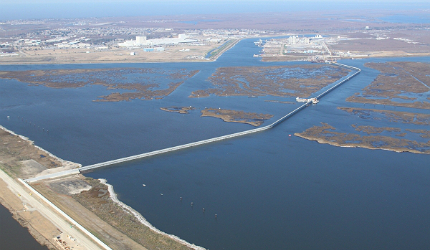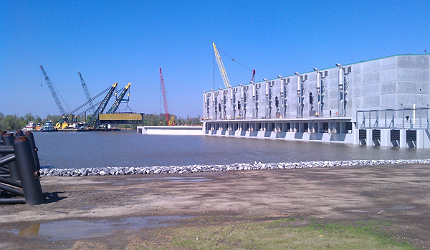Revamping New Orleans Flood Infrastructure Post-Katrina
In the wake of the death and devastation wrought by Hurricane Katrina, one of the worst natural disasters in US history, the federal government and some of its agencies were forced to ask themselves some hard questions. The complex system of levees and floodwalls encircling the greater New Orleans area was intended to keep the city and its residents safe in the event of a storm surge, such as the one which swept inland in August 2005.
Instead, the barriers failed dramatically, breaching in more than 50 separate locations along the hurricane protection system, according to a 2007 report by the American Society of Civil Engineers (ASCE). This allowed billions of gallons of water from the Gulf of Mexico, Lake Pontchartrain and Lake Borgne to surge in to New Orleans and the neighbouring parishes, claiming nearly 2,000 lives, leaving hundreds of thousands homeless and causing more than $100bn in damage to property and infrastructure.
The 2007 ASCE report highlighted fundamental design flaws in the hurricane protection system’s levees and floodwalls that contributed to the catastrophic flooding, most of which boil down to setting a margin of safety that was too low. The report draws particular attention to the lack of armouring against erosion in the levees, allowing large sections to be penetrated by the rushing water as softer soils gave way.
Overall, the flood protection system that failed in August 2005 was deemed to have been a piecemeal series of defences rather than a unified system, “with strong portions built adjacent to weak portions, some pump stations that could not withstand hurricane forces, and many penetrations through the levees for roads, railroads and utilities”.
Katrina’s aftermath: rebuilding New Orleans’ flood defences
Although the US Government and the US Army Corps of Engineers (USACE – the organisation behind the design and construction of the region’s flood protection system) were criticised for their decisions prior to and in the immediate aftermath of the storm, few could doubt the commitment from the government and USACE to quickly rebuild the area’s flood defences – bigger and better than ever before.

US Tariffs are shifting - will you react or anticipate?
Don’t let policy changes catch you off guard. Stay proactive with real-time data and expert analysis.
By GlobalDataRelated project
Tohoku Sky Village Concept, Japan
Tohoku Sky Village is a conceptual design for a set of artificial islands in the Tohoku region of Japan. The islands are designed as elevated landscape structures in the Pacific Ocean.
From USACE came a demanding schedule to provide 100-year-level risk reduction (a system capable of withstanding a peak flood that could be expected to arrive once in an average century) by 1 June 2011. This milestone was reached on time last year, an impressive feat made possible by a number of factors.
“The project at times required two shifts working seven days a week to meet USACE’s ambitious schedule,” says Larry Haser, IHNC programme manager of The Shaw Group, which was contracted by USACE to design and build the huge Inner Harbor Navigation Canal (IHNC) Lake Borgne Surge Barrier.
From the US Government came a huge rush of federal funding, all of which was provided upfront and without qualification. “Two separate administrations first made and then reaffirmed our nation’s commitment to the people of New Orleans by spending $14.6bn on what is the best risk reduction system certainly in the United States, if not indeed the world,” says USACE New Orleans District chief of public affairs Ken Holder.
“A major contributor to our success was upfront funding, rather than receiving funding incrementally. Upfront funding allowed us to meet our deadline.”
Louisiana’s Hurricane and Storm Damage Risk Reduction System (HSDRRS)
Today’s new Hurricane and Storm Damage Risk Reduction System (HSDRRS), which is still being improved despite passing its 100-year-level objective, is intended to address the design failures of the 2005 system, providing an interconnected system the likes of which the country has never seen before. The 133-mile perimeter defence system, with levees, flood walls, pumps stations and gated structures, incorporates a number of standout physical features.
The IHNC-Lake Borgne Surge Barrier is the largest civil works project in USACE’s history, and was completed with private contractor The Shaw Group, the beneficiary of the biggest design-build contract ever awarded by the Corps. The IHNC Surge Barrier is an imposing, 26ft tall structure which stretches nearly two miles across the Mississippi River Gulf Outlet and the Golden Triangle Marsh, a vitally important flashpoint in the event of sudden flooding.
The Seabrook Floodgate Complex, built just south of the Senator Ted Hickey Bridge, which consists of a 95ft-wide navigable sector gate, two 50ft-wide vertical lift gates and floodwall tie-ins, has been designed to work in conjunction with the IHNC-Lake Borgne Surge Barrier to protect some of the areas worst affected by Hurricane Katrina, including metro New Orleans, the Ninth Ward and St. Bernard Parish.
The final major feature of the HSDRRS is the Gulf Intracoastal Waterway (GIWW) West Closure Complex (WCC), a $1bn project which incorporates the largest pump station of its kind in the world, along with foreshore protection, water control structures and the largest sector gate in the US.
“The complex significantly reduces the risk to a large area of the west bank by removing 26 miles of levees, floodwalls, a gate and pumping stations along the Harvey and Algiers canals from the direct impacts of storm surge,” says Holder.
Speed, innovation and creative thinking: correcting past mistakes
The massive scale of the new HSDRRS is made clear by its very description, but USACE and project partners, such as The Shaw Group were forced to think creatively to ensure the system would be superior to its flawed predecessor, while also meeting the 100-year-level protection deadline of 1 June 2011.
From The Shaw Group’s perspective, the deadline meant that project phases usually kept separate had to be carried out at the same time. “The project team had to simultaneously design and construct the Surge Barrier,” explains Haser.
Related feature
Urban water design: strategies for future cities
Sustainably integrating water into modern cities will be one of the biggest challenges faced by future urban planners.
“This approach drastically shortened the project delivery time, but also created extremely difficult technical challenges, which required a heightened level of innovation and collaboration from all stakeholders.” Methods of speeding up the process included a streamlined document control procedures, daily problem solving meetings and constant real-time communication with USACE’s engineering team.
USACE has also been forced to innovate on the project to get it done on time and conform to stringent quality standards. Holder described USACE’s fast-track acquisition strategies as having more in common with military construction practices than those of civil works. The White House Council on Environmental Quality also granted special permission to the Corps to itemise its Environmental Impact Statements into smaller Individual Environmental Reports, which allowed each element of the HSDRRS to move to the construction phase more quickly.
“The Corps also employed innovative construction techniques to help overcome many of the challenges associated with construction in some of the worst soil conditions found in the world,” Holder says.
“For instance, the Corps used the deep soil mixing method along a stretch of levee being constructed in New Orleans East to increase the strength of the underlying poor soil, so that it could support the higher levee.”
Armouring the system’s levees, which involves strengthening the barriers with natural or artificial materials to increase their resiliency, has also been a major priority, given that a lack of armour was one of the main contributors to levee breaches in 2005.
“Armouring will help reduce scour and protect the integrity of the flood defence structure when confronted with severe wave overtopping from greater than 100-year storm surges,” explains Holder.
The role of modelling: designing USACE’s colossal civil engineering project
Seabrook Floodgate Complex, built just south of the Senator Ted Hickey Bridge, consists of a 95ft-wide navigable sector gate.
With the schedule so tight and the quality requirements so high, high-tech 3D design software and advanced meteorological modelling was unsurprisingly leveraged to ensure the project was backed up by detailed data. USACE used supercomputers to calculate the predicted impact caused by storms of all shapes and sizes. The Interagency Performance Evaluation Task Force analysed 152 storms to set an appropriate 100-year-level storm surge mark, including rarer storms ranging from 300 to 5,000-year-level hurricanes. “These data allowed the Corps to estimate the one percent chance or 100-year water elevations that were the basis for determining the structural specifications required,” Holder says.
The Shaw Group used similar methods to test the effectiveness of the IHNC Surge Barrier. 3D models verified the barrier’s overtopping rate, influencing the design of the project’s scour stone and other considerations. “Moreover,” says Haser, “a large basin model was also created for the area of the GIWW where the IHNC sector gate is located to study the effects of wave forces on the gate reflecting off of land-based T-walls and approach walls.”
USACE gathered other useful data for the overall project’s design from various US agencies and academic institutions, as well as extensive field trips to other world-famous flood protection systems, including those found in the Netherlands, a hub of expertise on water control. Indeed, Holder noted that Dutch contractors were brought on to the project to help design and build the HSDRRS.
While there still remains some work to be done on the most colossal civil engineering undertaking in USACE’s history (including more pump stations, canal closures and environmental mitigation), the lion’s share of the work has been accomplished. Although there will always be a risk of flooding from storms which exceed a system’s capacity, Holder notes that “the Greater New Orleans Hurricane and Storm Damage Risk Reduction System is better than at any time in the city’s history”.
With a new, toughened flood protection system now in place, and delivered in record time, New Orleans is better protected from storm surges than it has ever been before. For a city and a regional economy still struggling to put itself back together after Hurricane Katrina hit six years ago, this news has hopefully provided some comfort, along with a little breathing room to recover.
Related content
Urban water design: strategies for future cities
Sustainably integrating water into modern cities will be one of the biggest challenges faced by future urban planners. Elisabeth Fischer explores interdisciplinary water-sensitive urban design strategies that will help secure city life for future generations.
Louisiana Cancer Research Center, United States of America
The Louisiana Cancer Research Consortium (LCRC) was created through the Senate Bill 73 by the Louisiana State Legislature during the 2002 Special Session.
St Petersburg Flood-Prevention Facility, Russian Federation
With the long-awaited completion of the St Petersburg flood-prevention facility – the biggest construction project in eastern Europe, known locally simply as ‘the dam’ – 280 years of debate over the city’s flooding woes are set to come to an end in 2008.
Red River Floodway Expansion Project, Canada
Red River Floodway, also known as Duff’s Ditch, is a 48km artificial flood control waterway which was built between 1962 and1968 in Canada.





